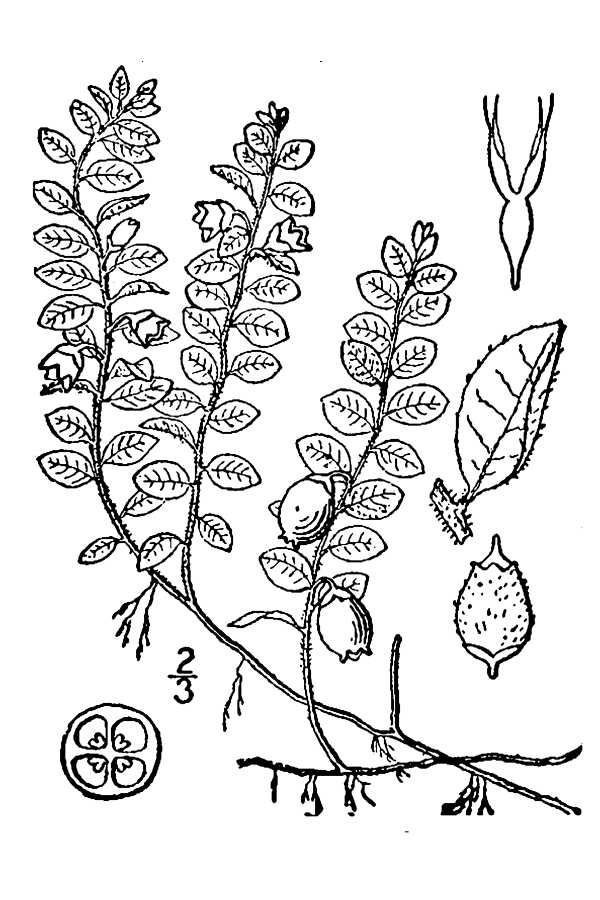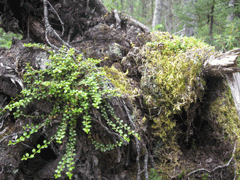 |
|
USDA-NRCS PLANTS Database / Britton, N.L., and A. Brown. 1913. An illustrated flora of the northern United States, Canada and the British Possessions. Vol. 2: 704. |
 |
| http://commons.wikimedia.org/wiki/User:Colocho |
Translate this page:
Summary
Gaultheria hispidula, is an evergreen fast-growing, prostrate shrub commonly known as the creeping snowberry. A useful fast growing ground cover plant for shady positions. The fruit is pleasantly acid and refreshing, with a delicate flavour of wintergreen. An agreeable sub-acid taste, similar to G. shallon. They can be made into delicious preserves. The fruit is about 6mm in diameter. Both the fruit and leaves can be eaten raw or cooked. The leaves are used to make a tea. A mild flavour of wintergreen. Said to be superior to china tea.
Physical Characteristics

 Gaultheria hispidula is an evergreen Shrub growing to 0.1 m (0ft 4in) by 1 m (3ft 3in) at a fast rate.
Gaultheria hispidula is an evergreen Shrub growing to 0.1 m (0ft 4in) by 1 m (3ft 3in) at a fast rate.
See above for USDA hardiness. It is hardy to UK zone 6. It is in leaf all year, in flower from May to June, and the seeds ripen from August to September. The species is hermaphrodite (has both male and female organs) and is pollinated by Insects.
Suitable for: light (sandy) and medium (loamy) soils. Suitable pH: mildly acid and neutral soils and can grow in very acid soils.
It can grow in semi-shade (light woodland). It prefers moist or wet soil.
UK Hardiness Map
US Hardiness Map
Synonyms
Chiogenes hispidula. Vaccinium hispidulum.
Plant Habitats
Woodland Garden Sunny Edge; Dappled Shade; Shady Edge; Ground Cover; Bog Garden;
Edible Uses
Edible Parts: Fruit Leaves
Edible Uses: Tea
Fruit - raw or cooked. Pleasantly acid and refreshing[3, 101], with a delicate flavour of wintergreen[183]. An agreeable sub-acid taste, similar to G. shallon[2, 11]. They can be made into delicious preserves[183]. The fruit is about 6mm in diameter[200]. Leaves - raw or cooked[207]. The leaves are used to make a tea[2, 95, 161, 257]. A mild flavour of wintergreen[183]. Said to be superior to china tea[207].
References More on Edible Uses
Medicinal Uses
Plants For A Future can not take any responsibility for any adverse effects from the use of plants. Always seek advice from a professional before using a plant medicinally.
Cancer Cytostatic Miscellany
The plant is said to remove the cancerous taint from the body[4]. An infusion of the leaves has been used as a tonic for a person who has overeaten[257].
References More on Medicinal Uses
The Bookshop: Edible Plant Books
Our Latest books on Perennial Plants For Food Forests and Permaculture Gardens in paperback or digital formats.

Edible Tropical Plants
Food Forest Plants for Hotter Conditions: 250+ Plants For Tropical Food Forests & Permaculture Gardens.
More

Edible Temperate Plants
Plants for Your Food Forest: 500 Plants for Temperate Food Forests & Permaculture Gardens.
More

More Books
PFAF have eight books available in paperback and digital formats. Browse the shop for more information.
Shop Now
Other Uses
References More on Other Uses
Cultivation details
Prefers a moist but not boggy humus rich soil in shade or semi-shade[11]. A peat and moisture loving species, it requires a lime-free soil[11]. The fruit is sometimes sold in local markets[61]. A fast growing plant[200]. The plant can make a good nesting place for mice, these mice then eat the bark of the stems in winter causing die-back. Plants in this genus are notably resistant to honey fungus[200]. Gaultheria japonica bears a close resemblance to G. hispidula (L.) Bigelow of N. America and sometimes treated as a variety or subspecies of the latter. G. japonica, however, has calyx much longer than the bracteoles, ovate and acute calyx lobes, and shorter anther projections. In G. hispidula the calyx is as long as or slightly longer than the bracteoles, the calyx lobes are broadly ovate and obtuse or subacute, and the anthers have distinct projections. For polyculture design as well as the above-ground architecture (form - tree, shrub etc. and size shown above) information on the habit and root pattern is also useful and given here if available. An evergreen. A clumping mat former. Forming a dense prostrate carpet spreading indefinitely [1-2]. The root pattern is flat with shallow roots forming a plate near the soil surface [1-2]. The root pattern is stoloniferous rooting from creeping stems above the ground [1-2].
References Carbon Farming Information and Carbon Sequestration Information
Temperature Converter
Type a value in the Celsius field to convert the value to Fahrenheit:
Fahrenheit:
The PFAF Bookshop
Plants For A Future have a number of books available in paperback and digital form. Book titles include Edible Plants, Edible Perennials, Edible Trees,Edible Shrubs, Woodland Gardening, and Temperate Food Forest Plants. Our new book is Food Forest Plants For Hotter Conditions (Tropical and Sub-Tropical).
Shop Now
Plant Propagation
The seed requires a period of cold stratification. Pre-chill for 4 - 10 weeks and then surface sow in a lime-free compost in a shady part of the greenhouse and keep the compost moist[78]. The seed usually germinates well, usually within 1 - 2 months at 20°c, but the seedlings are liable to damp off. It is important to water them with care and to ensure that they get plenty of ventilation. Watering them with a garlic infusion can also help to prevent damping of[K]. Prick out the seedlings into individual pots when they are about 25mm tall and grow them on in light shade in the greenhouse for at least their first winter[K]. Plant them out in late spring or early summer. The seedlings are susceptible to spring frosts so might need some protection for their first few years outdoors. The leaves remain very small for the first few years[11]. Cuttings of half-ripe wood 3 - 6cm long, July/August in a frame in a shady position. They form roots in late summer or spring[78]. A good percentage usually take. Division in spring just before new growth begins[200]. Larger clumps can be replanted direct into their permanent positions, though it is best to pot up smaller clumps and grow them on in a cold frame until they are rooting well. Plant them out in the spring. Layering.
Other Names
If available other names are mentioned here
Birchberry, moxie-plum.
Native Range
NORTHERN AMERICA: United States, New Jersey, Ohio, Pennsylvania, West Virginia, Wisconsin,
Weed Potential
Right plant wrong place. We are currently updating this section.
Please note that a plant may be invasive in one area but may not in your area so it's worth checking.
Conservation Status
IUCN Red List of Threatened Plants Status :

Growth: S = slow M = medium F = fast. Soil: L = light (sandy) M = medium H = heavy (clay). pH: A = acid N = neutral B = basic (alkaline). Shade: F = full shade S = semi-shade N = no shade. Moisture: D = dry M = Moist We = wet Wa = water.
Now available:
Food Forest Plants for Mediterranean Conditions
350+ Perennial Plants For Mediterranean and Drier Food Forests and Permaculture Gardens.
[Paperback and eBook]
This is the third in Plants For A Future's series of plant guides for food forests tailored to
specific climate zones. Following volumes on temperate and tropical ecosystems, this book focuses
on species suited to Mediterranean conditions—regions with hot, dry summers and cool, wet winters,
often facing the added challenge of climate change.
Read More
Expert comment
Author
(L.)Muhl. ex Bigelow.
Botanical References
11200
Links / References
For a list of references used on this page please go here
Readers comment
| Add a comment |
|
If you have important information about this plant that may help other users please add a comment or link below. Only comments or links that are felt to be directly relevant to a plant will be included. If you think a comment/link or information contained on this page is inaccurate or misleading we would welcome your feedback at [email protected]. If you have questions about a plant please use the Forum on this website as we do not have the resources to answer questions ourselves.
* Please note: the comments by website users are not necessarily those held by PFAF and may give misleading or inaccurate information.
To leave a comment please Register or login here All comments need to be approved so will not appear immediately.
|
Subject : Gaultheria hispidula
|
|
|
|